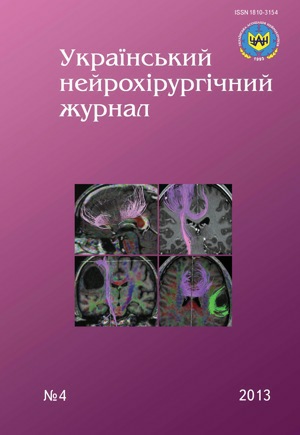Surgical tactics and results of posttraumatic syringomyelia treatment
DOI:
https://doi.org/10.25305/unj.55406Keywords:
posttraumatic cyst of the spinal cord, syringomyelia, shunting of cystsAbstract
Introduction. The purpose of the research was to study features of posttraumatic cysts flow and rational tactics for their treatment was developed.
Materials and methods. The research is based on results of 280 patients treatment. Surgical intervention was performed in 78 cases, in 69 — middle myelotomy with cysts opening, in 8 — different variants of subarachnoid shunt and in one — cyst-peritoneal shunt was applied.
Results. In 54 cases directly after surgery regression of neurological symptoms was observed. In these patients the period from post-traumatic cyst emergence to surgery performing did not exceed 3 years.
Conclusions. Simple cyst opening is possible only at adequate recovery of liquor circulation in the area of spinal cord injury. If you failed to restore liquor circulation, shunting of cysts is needed.References
1. Byun MS, Shin JJ, Hwang YS, Park SK. Decompressive surgery in a patient with posttraumatic syringomyelia. J Korean Neurosurg Soc. 2010 Mar;47(3):228-31. [CrossRef] [PubMed]
2. Jaksche H, Schaan M, Schulz J, Bosczcyk B. Posttraumatic syringomyelia - a serious complication in tetra- and paraplegic patients. Acta Neurochir Suppl. 2005;93:165-7. [PubMed]
3. Kim S, Choi S, Youm J, Kwon H. Syringo-subarachnoid-peritoneal shunt using T-tube for treatment of post-traumatic syringomyelia. J Korean Neurosurg Soc. 2012;52(1):58-61. [CrossRef]
4. Shields CB, Zhang YP, Shields LB. Post-traumatic syringomyelia: CSF hydrodynamic changes following spinal cord injury are the driving force in the development of PTSM. Handb Clin Neurol. 2012;109:355-67. [CrossRef] [PubMed]
5. Bonfield CM, Levi AD, Arnold PM, Okonkwo DO. Surgical management of post-traumatic syringomyelia. Spine (Phila Pa 1976). 2010 Oct 1;35(21 Suppl):S245-58. [CrossRef] [PubMed]
6. Kasai Y, Kawakita E, Morishita K, Uchida A. Cordectomy for post-traumatic syringomyelia. Acta Neurochir (Wien). 2008 Jan;150(1):83-6. [CrossRef] [PubMed]
7. Ko HY, Kim W, Kim SY, Shin MJ, Cha YS, Chang JH, Shin YB. Factors associated with early onset post-traumatic syringomyelia. Spinal Cord. 2012 Sep;50(9):695-8. [CrossRef] [PubMed]
8. Ushewokunze SO, Gan YC, Phillips K, Thacker K, Flint G. Surgical treatment of post-traumatic syringomyelia. Spinal Cord. 2010 Sep;48(9):710-3. [CrossRef] [PubMed]
Downloads
Published
How to Cite
Issue
Section
License
Copyright (c) 2013 Eugene Slynko, Andrey Dyadechko, Iyad Al-Kashkish

This work is licensed under a Creative Commons Attribution 4.0 International License.
Ukrainian Neurosurgical Journal abides by the CREATIVE COMMONS copyright rights and permissions for open access journals.
Authors, who are published in this Journal, agree to the following conditions:
1. The authors reserve the right to authorship of the work and pass the first publication right of this work to the Journal under the terms of Creative Commons Attribution License, which allows others to freely distribute the published research with the obligatory reference to the authors of the original work and the first publication of the work in this Journal.
2. The authors have the right to conclude separate supplement agreements that relate to non-exclusive work distribution in the form of which it has been published by the Journal (for example, to upload the work to the online storage of the Journal or publish it as part of a monograph), provided that the reference to the first publication of the work in this Journal is included.









